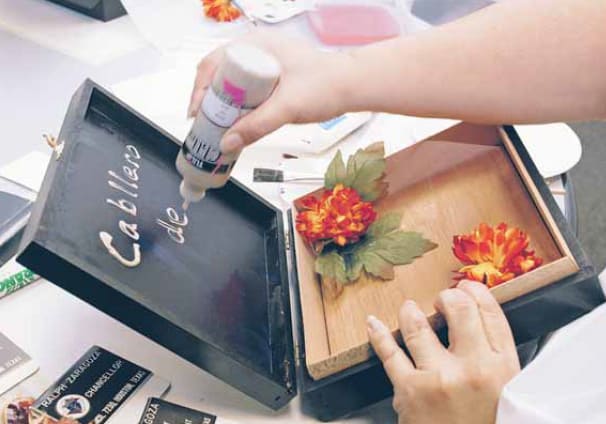
September 19, 2015
It looked like a craftsy person’s dream.
There were hot-glue guns, bright glass beads, pieces of a broken mirror, bags stuffed with ribbons and cloth and paints in all shades with festive names like “pumpkin” and “pretty pink.”
But this was no ordinary arts project. It was art therapy meets Día de los Muertos, or Day of the Dead, a largely Mexican and Mexican-American holiday that celebrates the dead and welcomes them home for the two day period coinciding with All Saints’ Day, today, and All Souls’ Day, Wednesday.
Included in traditional activities is the creation of ofrendas, which family members fill with photos, candles, food and marigolds.
Using the themes of this holiday she grew up with, psychotherapist and art therapist Angelina Rodriguez recently held two altar-building classes to encourage healing through art.
“People tend to not want to face grief, and they look at it as a negative experience, but there are gifts in grieving,” Rodriquez said.
As they created ofrendas in cigar boxes, several shared stories of the people they will remember today.
There wasn’t any gray paint, so Sally Mitchell, who admitted to having “no artistic talent at all,” used a paintbrush to stir globs of black and white on a paper plate. Then she smothered her ofrenda with the color, the same shade her son Joe had used on the 1972 Porsche he was restoring.
“He told me the day before, he said, ‘Mom, life is so perfect. I just don’t want to do anything to screw it up.’”
Although Joe was a motorcycle racer and supervised a racetrack, he was going only 30 mph when the Porsche flipped,
killing him at age 26.
“When you love being a mom, your identity so much is that,” she said. “I’d call out to the track and say, ‘Hi, this is Sally, Joe’s mom.’ You miss those phone calls.”
On her ofrenda Mitchell placed several pictures, including one of Joe, smiling ear to ear.
“A beer in one hand, a smile and a pretty girl,” Mitchell said, looking at a photo. “That was so Joe.”
Grace Zaragoza gently fingered a name tag that belonged to her father, Ralph, and placed it next to two plastic marigolds.
It was from his days with the Knights of Columbus, a Catholic men’s organization to which he had dedicated years of his life.
Next to her box on a notecard were words she used to describe the man who died a little over a year ago: “Caring. Religious. Hardworking. Responsible.”
“His love for us came through. What he did for us came through,” she said, adding that her father was a first generation Texan.
“He was Latino, but also he wanted to be part of this country.”
Just after making the ofrenda for her dad, her mother, who had been in hospice care, also died. She said taking time to process their deaths — which she will do again today — has helped her get through this difficult period.
“I just have a peaceful feeling,” she said. “I’m proud of what my mom did. I’m proud of what my dad did.”
It seemed weird at first, but Lisa Moscarelli finally decided that instead of honoring a loved one, she would honor a part of herself for Día de los Muertos.
Fresh out of a 12-year relationship, Moscarelli dedicated her ofrenda to the person she was then, in hopes of moving to a new chapter of her life.
“This whole thing, you have to be honest, because it comes from a place in your soul,” the 42-year-old said.
“You can’t fake it.”
On the lid of her ofrenda she wrote words like “serenity” and “healing.”
With a picture of her ex she included a picture of herself singing — something she loves.
“It served as a good reminder to keep what we really have passion for out in front of us, because then we’re able to have it flowing in our lives,” she said.
As a child, Dora Trevino watched her mother set out pictures, candles, food and drinks every Nov. 1 for loved ones who had died.
This year, Trevino has created her own shrine in memory of a baby whom she never got to teach those traditions.
“It being our first child, we were all excited,” said Trevino, who, with her husband, is mourning the loss of a child she miscarried almost a year ago.
“I had a hard time, because I didn’t have anything. There’s no pictures. No memories.”
On top of her ofrenda, Trevino pasted a magazine cutout of a little girl and veiled it with a thin, gauzy material. Then she lined the box with a rippled white ribbon.
“Now that I’m looking at it, it kind of looks like a casket,” she said.
Inside she placed bib and bootie shapes cut from pink gingham, marigolds, a candle and her hospital wristband.
“I guess that’s one of those things that happens and you block it out or you don’t want to think about it. You don’t want to talk about it,” she said.
“It was good for me to be able to talk about it without breaking down.”
©2025 Angelina H. Rodriguez, Ph.D., LPC-AT/S, ATR-BC
4747 Bellaire Blvd., Ste. 545, Bellaire, Texas 77401 | Call 832-986-8477
Office Hours: MON - FRI 9:00 am to 6:00 pm
Privacy Policy | Site Map
Leave a Reply